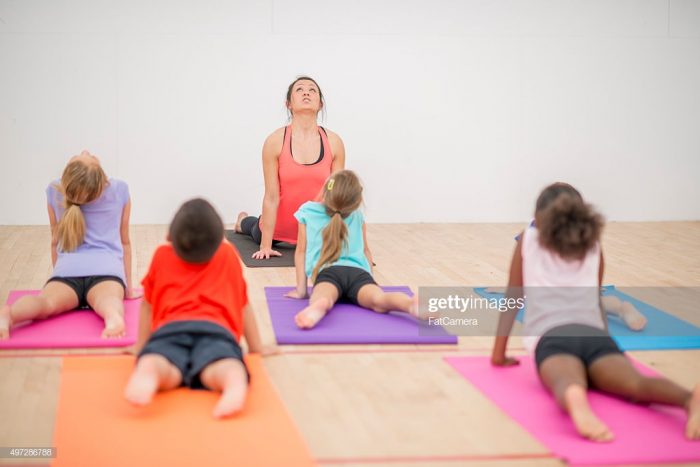In the modern world, children are growing up in the world of busy parents, academic pressure, the digital world, and competitive sports.
You as parents might think that these activities are not stressful at all, but they can be for many. Schools, sports, and social activities are having profound effects on the children, and unfortunately they are negative.
A regular yoga practice can help children to deal with these pressured situations. When children learn yoga for self-health, mental relaxation, and awareness, they can deal with life’s challenges with greater ease. Yoga practices at an early age can develop a great self-esteem and body awareness with a non-competitive physical activity.
Children derive enormous benefits from yoga practice. Yoga helps them to connect with their inner self and develop an intimate relationship with nature and society. Yoga brings the inner peace that improves the concentration level. The selection of yoga practice for different age groups is a crucial process in yoga. Here are some basic instructions for every age group children to practice yoga:
- 5-10 Years Age Group – This is the right time to give your child their own yoga mat and start learning yoga practices with simple stretches and body postures. Make them practice next to you and let me them make the practise decision for yoga asanas. You need to engage them for 15 to 30 minutes at this age. The goal for them is to learn a few basic yoga poses like forward fold or downward dog. Also, you need to teach kids regarding posture effects by giving them exciting names. The main focus is to build the interest among kids and teaching them health benefits.
- 10-15 Years Age Group – During this age, the imagination power of your child is highly active. This is the right that you can introduce the mindfulness meditation to them. Also, you need to teach them emotional aspect of yoga and have them realise that yoga is a great tool to deal with the changes in the body and mind.
- 15-18 Years Age Group – This might be the toughest age to keep the children’s interest in yoga practice. It is the age of distraction towards outer world and very challenging to value the internal peace and continuous practice. The best way to keep them engaged in yoga practice is to have them practice with you. Practicing with them around 45-60 minutes and focus to develop them with a sense of responsibility. At this stage, kids want freedom and make their own decision. You need to add some meditation techniques with their yoga practice as it is the best way to keep them focus in their daily lives and improve their mental health.
Benefits for children to practice Yoga – There are five ways that kids can benefit from the practice of yoga: –
- Development of Physical Strength – The first benefit of a regular yoga practice is your physical fitness. It strengthens your muscles, make them more flexible. Practicing yoga allows children to use their muscular strength in new and challenging ways. You get a better understanding of the physiological anatomy of the body and shape it according to your sports.Learning different yoga poses allows children to become better acquainted with themselves and others. They become more aware of their bodies which helps them realize just how powerful and capable their bodies are!
- Development of Mental Calmness – Our daily yoga practice not only helps us to keep the calm our mind calm, it also teaches us how to control our mental responses in any situation. According to a health research, yoga sharpens our senses and makes us more alert and make our more alert than in comparison to doing aerobics or doing nothing at all.
- Development of Mindfulness – Research shows that the practices of yoga & mindfulness help to decrease the stress and anxiety and promote emotional wellness. Mindfulness emphasizes the practice of mind to focus consciously in the present moment without any attachment with it. The breathing & mindfulness techniques are helpful in relaxing mind & body and improve the concentration that helps children to achieve greater results in their academic & sports.
- Development of Self-Confidence – One of the greatest qualities of yoga is that it focuses on your inner being rather than the outer world. It evolves the spiritual aspect of your inner being rather than competition. Yoga encourages you to develop your own path and move with your ability and constantly improve it. Yoga develops the positive attributes like perseverance, patience, constant learning process, setting up goals and hard work to achieve it. All these positive qualities develop the higher self-confidence in yoga practising Children.
- Development of Self-Discipline and Self-Control – Yoga in itself requires a great level of self-discipline and more accountability from self. Either you need to develop it by self or with the help of a Yoga Master. So, self-discipline educates children to respond more thoughtfully and purposefully on challenging situations and make them more responsible, productive and independent.
- Development of Social Skills – The process of yoga process is structured in such a manner that it requires children to follow the instructions and practice accordingly. When you practice yoga in a group and it develop a sense of teamwork and other social skills and help them to complete the complex challenges of academics and sports as a team.
Recommended Yoga Poses for Children – Not all the asanas are recommended for children but few are recommended that are beneficial for their physical and mental growth. Here are recommended yoga asanas for children: –
- Cat/Cow Pose – Cat-Cow posture is a flow between two poses and increases the flexibility of the neck, shoulder and spine. It stretches the muscles of the entire body including hips, back, abdomen, chest and lungs primarily. It makes children’s body more flexible and sporty.
- Eagle pose i.e. Garudasana – Eagle pose is a standing balance posture and stretches the shoulder and upper back with strengthening the thighs, hips and calves muscles. It develops the balance, calm focus and concentration. This pose helps to protect knee injury during the school’s sports event.
- Tree Pose i.e. Vrksasana – Tree pose resembles a tree and balances the left and right side of the brain. It stretches the thigh muscles, groins, torso and shoulders. It strengthens the ankles, calves and tones the abdominal muscles. It develops a meditative state of mind in children.
During childhood, the prime purpose of yoga practice is to develop the physical and mental strength. After the age of 18, children are allowed to practice the complex yoga asanas. Now, they are ready to attend any yoga retreat, beach classes independently as these classes are one of the best ways to develop their interest in further yoga practices. They will be eager to explore the universe and the science of yoga will allow them to know the reality of the universe. It is the right time to be a mentor them with a real philosophical part of yoga and draw ultimate picture of yoga philosophy. As a first mentor, you need to find the right mentor for them and get them the membership of a yoga studio or yoga school in town, near their college or to an online class and be along with them to develop their constant interest.
Some of the yoga school offers the yoga retreats for children which are designed to mentor children on the physical and mental growth. The focus of these retreats are the detailed study of the human physiology, developing physical strength and mindfulness which helps them in their adolescent age and make them a better personality. Perhaps it can develop their interest to go for a yoga teacher training to choose yoga as a career option.












Read 0 comments and reply